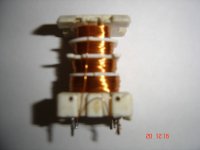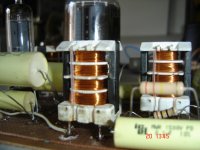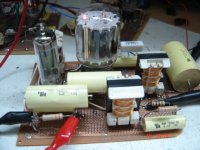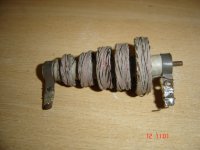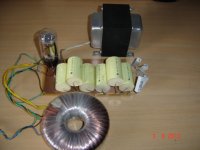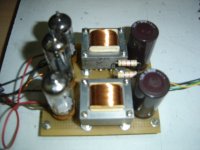What I am looking for should be simple to get wound : 50H 40mA . Information regarding plate choke design seems few and far between . I can understand that in the context of using a parafeed output stage , the choke will see a much larger voltage swing at lower frequencies than a power supply choke but apart from that what makes a plate choke different to a power supply choke ?
cheers
316a
cheers
316a
A plate choke must maintain a high impedance across the whole audio band and, ideally, beyond.
Well that's obvious but power supply chokes I have tested , have provided adequate results . Output transformers connected as chokes also good results , even those that measured poorly as output transformers . What I am interested in are the design considerations in correctly specifying such a device to get the best performance . Most appear to be nothing special , just a single winding inside a single chamber bobbin , the core size tending to be much larger than a comparable psu choke . It can't be this simple though , can it ?
cheers
316a
Leakage L is no longer a problem, but distributed capacitance is.
So make sure to get a layered winding with sufficient inter-layer insulation. I wouldn't be surprised if some power supply inductors are random wound. One fix-up approach would be to use series inductors, with one of them specifically designed for high freq. isolation. DC current must be handled correctly (via gapping or a P-P CT'd choke).
The real challenge is making a CT'd plate inductor (a "balancing inductor") with good coupling from side to side. Don't see these around anymore, but they are the key to all high performance design.
So make sure to get a layered winding with sufficient inter-layer insulation. I wouldn't be surprised if some power supply inductors are random wound. One fix-up approach would be to use series inductors, with one of them specifically designed for high freq. isolation. DC current must be handled correctly (via gapping or a P-P CT'd choke).
The real challenge is making a CT'd plate inductor (a "balancing inductor") with good coupling from side to side. Don't see these around anymore, but they are the key to all high performance design.
Last edited:
A plate choke must maintain a high impedance across the whole audio band and, ideally, beyond.
And so must a PS choke. In fact there is no difference in the requirements for geometry and core material. Lundahl even state there is no difference between their plate and PS chokes.
Perhaps, if there is a difference, it only concerns the L and R values which are commonly much higher in plate load applications.
I wouldn't be surprised if some power supply inductors are random wound.
Unfortunately lots of those around. Unacceptable as PS chokes as well.
It can't be this simple though , can it ?
It is not. My winder claims it takes him longer to wind a good choke, than an output transformer. He uses a proprietary multilayer winding scheme. The results, especially on high permeability cores are fantastic.
It is not. My winder claims it takes him longer to wind a good choke, than an output transformer. He uses a proprietary multilayer winding scheme. The results, especially on high permeability cores are fantastic.
Ok...
Are your chokes wound on a single chamber bobbin ?
cheers
316a
In my experience, chokes are very easy. Catch a core and a bobbin. Wind in the bobbin as much turns as you can, taking into account DCR and space in the window. Assemble the core, E´s and I´s separated. Assume some low air gap (a piece of paper, to start). Put the choke to run in the desired circuit, and inject a small input signal to the amp, and increase it until plate voltage gets just cutted, and at the lowest frequency you want it run properly. With care of the high voltage, increase or decrease the gap, adjusting signal level until you have the largest signal without distortion at the plate. Then, fix the I's to the E's laminations with an non magnetic piece. This is the gap that at this AC + DC currents give best inductance. Enjoy the amp.
Some years ago I made those for an all-tube-SMPS (SEPIC + Cuk). Note the similitude with a RF choke, from I took the idea.
Attachments
Last edited:
Leakage L is no longer a problem, but distributed capacitance is.
So make sure to get a layered winding with sufficient inter-layer insulation.
Good point. Back-winding also helps to redistribute capacintace. Otherwise a more complex winding techique is needed.....
Lundahl even state there is no difference between their plate and PS chokes.
Because they are well layered and done thee same way.
Their transformers are not always good enough though....much less flexible than what they claim in their datasheet.
Not really, at least not to the same extent.analog_sa said:And so must a PS choke.
I just dropped in a pair of Transcendar 10 watt OPT 5K:8R which have a particularly fat stack of lams . 40H at 120Hz apparently , I seem to remember Geri used a lot of sectioning in his designs but I can't see any reference to the number of sections used . A lot more crispness and better dynamics than the junkers which sounded pretty good in comparison to a CCS .
cheers
316a
cheers
316a
- Status
- This old topic is closed. If you want to reopen this topic, contact a moderator using the "Report Post" button.
- Home
- Amplifiers
- Tubes / Valves
- Design considerations of plate chokes
